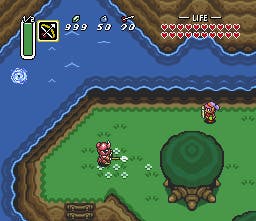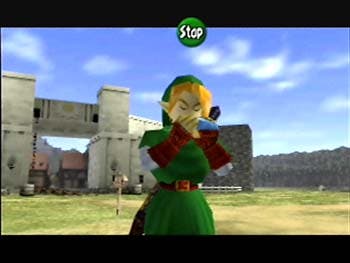The History of Zelda - Part 1
A link to the past.
The Legend of Zelda: A Link to the Past, 1992
"This land was like no other..."
Now this is more like it. The Legend of Zelda: A Link to the Past is one of the defining games of the SNES generation and without a doubt one of the finest 2D games ever created. Few other games have ever been so impossibly enticing, so huge in scope or so cleverly, tantalisingly structured as this. The first game in the series to have anything that could be considered a proper story, A Link to the Past was set in a Hyrule on the verge of collapse and plopped you down into an enormous world a hundred times richer and more developed than the NES titles'. It had properly nefarious, oppressive tyrants to defeat and maidens who actually needed rescuing, drunken, grieving fathers to comfort, sages in hiding, snitches, recluses, rebels and ghostly flute-players hiding in forests. It is almost impossible to play through this game sequentially, so numerous and tempting are the optional diversions.

Link to the Past's absolutely enormous overworld was absolutely packed with possibilities and sidelines and random little caves and fogged-over corners of the map to explore and uncover. It recaptures that joy of discovery and exploration that was key to the original Legend of Zelda and keeps you playing hour after hour with the eternal promise that there's something unbearably exciting just around the corner - a hook that is now something of a Zelda trademark. It gave you glimpses of pathways blocked off by staves, inaccessible caves cleverly positioned right at the edge of a square of the map so that you couldn't quite figure out how to get to them, and obstacles that clearly needed an elusive-but-never-too-elusive item to overcome. Upon the discovery of every new item or ability, whole new levels of the map opened themselves up, waiting for you to arrive and feast upon their delicious secrets, whether they be pieces of heart, a chestful of Rupees or a difficult-to-find item hidden behind a crack in a desert cliff. The dungeons, too, are wonderfully multi-layered, varied and fiendish - they take block-pushing and switch pulling to the absolute limits of their capabilities.
Link to the Past is a bastion of excellent 2D game design, and it rewards playful experimentation and explorative curiosity like few other games ever have; it embodies a lot of what people love about the Zelda series. Often when one revisits old greats, it becomes apparent that although they were incredible for their time, they ultimately ended up serving as stepping-stones to something better. But no 2D Zelda ever surpassed Link to the Past, and in the eyes of many diehards, no 3D one ever could.
The Legend of Zelda: Link's Awakening, 1993
"(It's a little bit mysterious)"

Link's Awakening was the first of the series' deviations from the seemingly neverending story of Hyrule and the Triforce. Spacey and surreal, Link's Awakening's alternate-reality island setting bore an overwhelming resemblance to LttP's Hyrule, incorporating many of the same characters, bosses and artwork, but it was a touch stranger and slyly self-referential. It's full of riddles and dream imagery as opposed to Link to the Past's clear-cut good-versus-evil premise, and the story is much more open to interpretation. Link's Awakening began the Zelda series' musical tradition, awarding a musical instrument at the end of each dungeon, and also was the first to feature the lengthy and convoluted trading sequence that is now a series staple.
Nobody really expected a handheld Zelda game to equal LttP in size, but Link's Awakening comes extremely close. Its emphasis, though, is upon the dungeons as opposed to exploration of the overworld, which suits the handheld format better - it is it is much easier to play Link's Awakening in a linear fashion. The dungeons are typically superbly made (some of the end-of-dungeon Nightmare bosses are inspired - the Bottle Cave genie springs to mind) and the slightly tweaked control and more compact design made this well-suited to the Game Boy, but despite the allure of the dreamlike setting, Link's Awakening doesn't quite have the scope or appeal of LttP.
I remember it chiefly for its strangeness and slight melancholy, which perhaps was inspiration for Majora's Mask. The gradual discovery that Koholint is but a dream world and that it will disappear when the Wind Fish awakens is compelling, and Link's Awakening's weird and often humorous dialogue is some of the series' most memorable.
The Legend of Zelda: Ocarina of Time, 1998
"Hey... LISTEN!"

When I think about Ocarina of Time, I don't think about those first few awestruck steps into Hyrule Field, or the music of Gerudo Valley ,or getting stuck in the Water Temple, or rearing up into the sunset having 'liberated' Epona from her nice comfortable ranch, or any of the other slightly twee things that Zelda fans tend to come up with when you mention the game. I remember all of those things, of course, but not as strongly as I remember the agonising, interminable five-year wait that we all had to endure before Ocarina of Time eventually made it to the UK. If any game adequately represents the amazing ability of Nintendo fans to whip themselves into an absolute frenzy over as little as a blurry screenshot (and Nintendo itself's remarkable capability to completely neglect its devoted fanboys), this has got to be it.
It says an awful lot for Ocarina of Time that even after such fevered anticipation and unbearable hype, it didn't disappoint even in the slightest. It was everything that anyone wanted of a 3D Zelda beautifully designed, masterful of its hardware, atmospheric, varied and suffused with character. More than any preceding game in the series, Ocarina of Time had a greatly involving story; though understated, moments like adult Link's first steps into a desolate, decaying, nightmarish future Hyrule and a terrified Princess Zelda fleeing the castle in the dead of night with Ganondorf's black steed close behind had a lot of narrative impact. Hyrule felt like a credible world in Ocarina of Time, populated by an imaginative and wonderfully varied array of creatures, people and enemies. This was a world you could lose yourself in, and though it lacked the characterisation and FMV storytelling techniques of the PlayStation RPGs of its time, its story and setting were no less absorbing.
Miyamoto once said that making Ocarina of Time "was like losing my virginity, in the sense that we were making something completely new and never done before". Indeed, this game definitely marks the point at which the Zelda series grew up. There are more complex themes here than in Link to the Past, harder puzzles, scarier moments and a more richly characterised world. Ocarina of Time knew how to work within the limitations or its hardware, and its visual style and superb audio made it extremely atmospheric. The lack of pre-rendered sequences and loading times meant that OoT's Hyrule felt consistent and natural, from the dark and frightening depths of the Shadow Temple to the sunny, cheerful market square outside Hyrule Castle.

For a first attempt at a 3D Zelda (or any 3D adventure game of this scope, come to think), Ocarina of Time's gameplay and design are remarkably accomplished. Even today it is difficult to find shortcomings in its control (its Z-Targeting combat system has yet to be bettered), and it goes without saying that Ocarina of Time had a tremendous impact on videogaming as a whole. Its sheer interactivity remains mind-boggling, even in an age where almost every adventure game adopts a non-linear, go-anywhere-do-anything approach. You can pick up rocks, swim in rivers, climb things, hit things, talk to things, collect things, see a mountain in the distance and run right up to it - where RPGs limit the player through levels, experience and equipment, Ocarina of Time barely limits you at all. It is full of inspired gameplay elements (Epona, the ocarina songs, Navi) that, despite their diversity, somehow form one cohesive whole. This really is among the very, very best games that have ever been made, and in an industry where even those best games are often lambasted by vocal critics, the fact that it's still difficult to find anyone with a bad word to say about it is testament to its lasting appeal.








